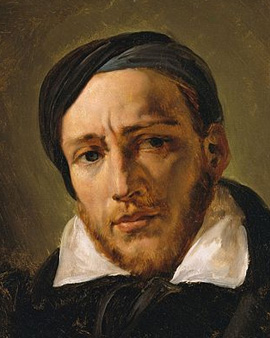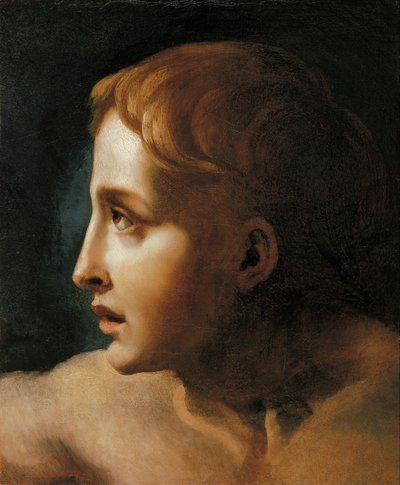The cultural-historical epoch "Romanticism", which began at the end of the 18th century and lasted well into the 19th century, was influenced by important artists such as the French painter, sculptor, lithographer and draughtsman Théodore Géricault. His relatively short life was moving, if not stormy, and gave rise to numerous myths about him. In 1814 he fell in love with his aunt Alexandrine, six years his senior, a romantic and at the same time impossible love. The relationship produced a son who was passed off as the child of a maid. Only after the death of Théodore Géricault, the grandfather officially recognized the boy as a member of the family.
Théodore Géricault, who came from a well-off family, had the opportunity to live out his enthusiasm for horses. As he also had an interest in fights and battles, this was reflected in his works, such as the portrait of Lieutenant Dieudonné (God-given). Théodore Géricault, who studied at the Ècole de Beaux-Arts in Paris, concentrated on depictions of figures, especially military scenes. At the age of 21 he already received prizes for his works and became famous. His circle of friends included artists like a master of the romantic era: Eugene Delacroix.
Many of Théodore Géricault's works must be considered gigantic. His famous oil painting: "Le radeau de la Méduse" (Engl. The Raft of the Medusa) measures about 7 m x 5 m and is now exhibited in the Paris Louvre. This picture is not an imaginary representation. Théodore Géricault criticized the dramas that arise when unqualified people take responsibility. After a ship ran aground, a raft for 400 people was built. The pyramid-like painting depicts horrible scenes such as death and cannibalism. For this the painter studied the colours which highlight the corpses particularly well. It may sound cruel, but this way he got a realistic picture. Today photos are taken or films are made. In those days, artists like Théodore Géricault created images of contemporary history. He recorded what should not be forgotten and made art an expression of his critical attitude.
×





.jpg)
.jpg)
.jpg)
.jpg)
.jpg)
.jpg)
.jpg)
.jpg)
.jpg)
.jpg)
 c1818-19 - (MeisterDrucke-110401).jpg)
 c1818-19 - (MeisterDrucke-110401).jpg)
.jpg)
.jpg)
_-_(MeisterDrucke-27931).jpg)
_-_(MeisterDrucke-27931).jpg)
 - (MeisterDrucke-54382).jpg)
 - (MeisterDrucke-54382).jpg)
.jpg)
.jpg)
.jpg)
.jpg)
.jpg)
.jpg)
.jpg)
.jpg)
_-_(MeisterDrucke-969873).jpg)
_-_(MeisterDrucke-969873).jpg)
.jpg)
.jpg)
_19th_cen_-_(MeisterDrucke-972283).jpg)
_19th_cen_-_(MeisterDrucke-972283).jpg)
.jpg)
.jpg)
.jpg)
.jpg)
.jpg)
.jpg)
.jpg)
.jpg)
.jpg)
.jpg)
.jpg)
.jpg)
.jpg)
.jpg)
.jpg)
.jpg)
.jpg)
.jpg)
.jpg)
.jpg)
.jpg)
.jpg)
.jpg)
.jpg)
_by_Jean-Louis_Theodore_Gericault_(1791-1_-_(MeisterDrucke-1423962).jpg)
_by_Jean-Louis_Theodore_Gericault_(1791-1_-_(MeisterDrucke-1423962).jpg)
.jpg)
.jpg)
.jpg)
.jpg)
.jpg)
.jpg)
.jpg)
.jpg)
.jpg)
.jpg)
.jpg)
.jpg)
.jpg)
.jpg)
_at_Battle_of_Chacabuco_February_-_(MeisterDrucke-1088297).jpg)
_at_Battle_of_Chacabuco_February_-_(MeisterDrucke-1088297).jpg)
.jpg)
.jpg)
.jpg)
.jpg)
.jpg)
.jpg)
_-_(MeisterDrucke-985698).jpg)
_-_(MeisterDrucke-985698).jpg)
_-_(MeisterDrucke-1426135).jpg)
_-_(MeisterDrucke-1426135).jpg)
.jpg)
.jpg)
_-_(MeisterDrucke-1659685).jpg)
_-_(MeisterDrucke-1659685).jpg)
.jpg)
.jpg)
.jpg)
.jpg)
.jpg)
.jpg)
.jpg)
.jpg)
.jpg)
.jpg)
.jpg)
.jpg)
_-_(MeisterDrucke-1002884).jpg)
_-_(MeisterDrucke-1002884).jpg)
.jpg)
.jpg)
.jpg)
.jpg)
.jpg)
.jpg)
.jpg)
.jpg)
_-_(MeisterDrucke-114738).jpg)
_-_(MeisterDrucke-114738).jpg)
.jpg)
.jpg)
.jpg)
.jpg)
_-_(MeisterDrucke-1425060).jpg)
_-_(MeisterDrucke-1425060).jpg)
.jpg)
.jpg)
_-_(MeisterDrucke-1659425).jpg)
_-_(MeisterDrucke-1659425).jpg)
.jpg)
.jpg)
.jpg)
.jpg)
.jpg)
.jpg)
.jpg)
.jpg)
_18_-_(MeisterDrucke-1022803).jpg)
_18_-_(MeisterDrucke-1022803).jpg)
_-_(MeisterDrucke-1584742).jpg)
_-_(MeisterDrucke-1584742).jpg)
_-_(MeisterDrucke-999134).jpg)
_-_(MeisterDrucke-999134).jpg)
.jpg)
.jpg)
.jpg)
.jpg)
.jpg)
.jpg)
.jpg)
.jpg)
_1_-_(MeisterDrucke-1023136).jpg)
_1_-_(MeisterDrucke-1023136).jpg)
.jpg)
.jpg)
.jpg)
.jpg)
.jpg)
.jpg)
.jpg)
.jpg)
.jpg)
.jpg)
.jpg)
.jpg)
.jpg)
.jpg)
 - (MeisterDrucke-44523).jpg)
 - (MeisterDrucke-44523).jpg)
.jpg)
.jpg)
.jpg)
.jpg)
.jpg)
.jpg)
.jpg)
.jpg)
_-_(MeisterDrucke-1659559).jpg)
_-_(MeisterDrucke-1659559).jpg)


_19th_century_Oil_on_canvas_-_(MeisterDrucke-1002216).jpg)
_19th_century_Oil_on_canvas_-_(MeisterDrucke-1002216).jpg)
.jpg)
.jpg)
.jpg)
.jpg)
.jpg)
.jpg)
.jpg)
.jpg)
.jpg)
.jpg)
.jpg)
.jpg)
.jpg)
.jpg)
.jpg)
.jpg)
.jpg)
.jpg)
.jpg)
.jpg)
.jpg)
.jpg)
.jpg)
.jpg)






